
(Photo: J. Maus/BikePortland)
“I’m fully cognizant of the fact that [congestion pricing] may not happen before this project and I certainly don’t want to see this project fall by the wayside because of that.”
— Dan Saltzman, City Commissioner
As the Oregon Department of Transportation tries their best to move forward with a project to widen Interstate 5 through the Rose Quarter, there remains broad support from experts, activists, insiders — and even politicians — that charging a toll to drive on the freeway is the most sensible way to respond to congestion concerns.
But until last week it had been all talk and posturing. That was before City Commissioner Dan Saltzman (who oversees the Portland Bureau of Transportation) drafted an amendment to an action item on the project in the Central City 2035 Plan. At their October 18th work session on the plan, Portland City Council agreed with Saltzman on an idea we first reported on back in September: That ODOT must implement congestion pricing on I-5.
But the devil is in the details. When would the tolls start? Would they be legal? How committed is the City of Portland to congestion pricing on I-5? Are they willing to risk the entire project if it doesn’t happen?
Saltzman’s amendment (a stronger version of an existing action item for the project) was seconded during the work session but still isn’t an official part of the CC2035 plan. PBOT will now spend six weeks refining the idea before it comes back to council on November 30th.
Here’s the language of the amendment that was supported by council last week (notice the changes from the previous version):

Words matter here. Notice that Saltzman’s language calls for the implementation of congestion pricing “… prior to the opening of this project.” That’s different than the language his office gave us on September 1st when he wanted to, “Include congestion/value pricing before the project breaks ground.”
There’s a big difference between doing something before a shovel hits the dirt and doing it before the ribbon is cut.
Advertisement
“This [action item on congestion pricing] is what you want to see happen. It doesn’t mean that the project can’t happen if we don’t meet that action.”
— Art Pearce, PBOT
Mayor Ted Wheeler had some questions for PBOT staff at the work session last week. “I support congestion pricing and I support Commissioner Saltzman’s efforts. One possible hitch in all this: Who gets to decide that? Do we control that? Does the state control that? Or are we beholden to the federal government?”
“A little bit of all of those things,” replied PBOT Policy, Planning and Projects Group Manager Art Pearce. “The state needs to apply to the federal government for approval, and that’s what the legislature directed ODOT to do… to undertake a study in order to apply for approval to implement the program.”
Then Wheeler asked what would happen if the feds said “no” to congestion pricing. “I would hate to see all of the other aspects of this project go by the wayside and the funds returned to the state so they could use it to expand I-205 if the federal government doesn’t give us what we need right now,” he replied to Pearce. “I’m somewhat hesitant to throw down a gauntlet when I don’t know who’s picking it up on the other side.”
Then Pearce said something that should give pricing advocates pause. In describing Saltzman’s stronger language for the congestion pricing action item, he said, “It’s saying, this is what you want to see happen. It doesn’t mean that the project can’t happen if we don’t meet that action.”
With a worried look on his face, as if he realized how Pearce’s comments might be heard as being too weak on the city’s congestion pricing demands and wanted to make sure something stronger was on the record, Wheeler spoke directly to Pearce, “I want to clariy: Is that Commissioner Saltzman’s intent? Because I’m not sure you got that right.”
“Our intention is to see that [congestion pricing] happen,” Pearce replied.
Then Saltzman himself spoke up. “I want to see this happen. I think you have to push the bureaucracy in order to make something like this happen because it is a new concept, at least on the west coast. But I’m fully cognizant of the fact that it may not happen before this project and I certainly don’t want to see this project fall by the wayside because of that.”
And with that, Wheeler said, “Then you have me standing shoulder-to-shoulder with you on this. This is obviously an important project for the state. An important project for the City of Portland. I believe it has the opportunity to be transformational for this part of our city.”
Keep in mind that PBOT is a very strong partner with ODOT in support of the I-5 Rose Quarter Project — new freeways lanes and all. They’ll have to walk a fine line between demands for congestion pricing and a state agency that doesn’t seem to want it on the I-5 project.
At a major public hearing on the project back in September, an ODOT staffer threw cold water on congestion pricing by suggesting it would unfairly hurt low-income people. And in a story reported by Oregon Public Broadcasting on October 13th, ODOT Assistant Director Travis Brouwer “raised doubt about whether it makes sense to even try to impose tolls in the Rose Quarter.” Brouwer told OPB’s Jeff Mapes that, “It’s not clear that it is one [section of freeway] that would lend itself real well to congestion pricing.”
With council support for congestion pricing firmed up, PBOT’s Pearce told Mayor Wheeler and the commissioners that, “Our intention is to bring a much clearer point to the congestion pricing conversation about six weeks from now.”
Stay tuned.
— Jonathan Maus: (503) 706-8804, @jonathan_maus on Twitter and jonathan@bikeportland.org
Never miss a story. Sign-up for the daily BP Headlines email.
BikePortland needs your support.

